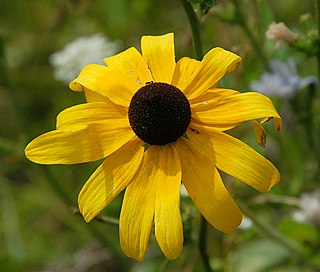
Rudbeckia hirta, commonly called black-eyed Susan, is a North American flowering plant in the family Asteraceae, native to Eastern and Central North America and naturalized in the Western part of the continent as well as in China. It has now been found in all 10 Canadian Provinces and all 48 of the states in the contiguous United States.

Luina, commonly called silverback, is a small genus of perennial shrubs in the groundsel tribe within the sunflower family.
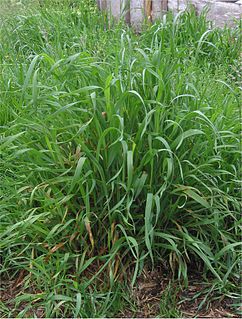
Elymus repens, commonly known as couch grass, is a very common perennial species of grass native to most of Europe, Asia, the Arctic biome, and northwest Africa. It has been brought into other mild northern climates for forage or erosion control, but is often considered a weed.

Rudbeckia is a plant genus in the Asteraceae or composite family. Rudbeckia flowers feature a prominent, raised central disc in black, brown shades of green, and in-between tones, giving rise to their familiar common names of coneflowers and black-eyed-susans. All are native to North America, and many species are cultivated in gardens for their showy yellow or gold flower heads that bloom in mid to late summer.
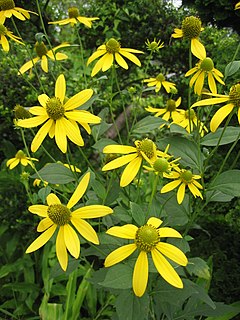
Rudbeckia laciniata, commonly called cutleaf coneflower, is a species of flowering plant in the aster family (Asteraceae). It is native to North America, where it is widespread in both Canada and the United States. Its natural habitat is wet sites in flood plains, along stream banks, and in moist forests.

Dracopis is a monotypic genus with Dracopis amplexicaulis the sole species. It is native to North America.

Echinacea tennesseensis, also known as the Tennessee coneflower or Tennessee purple coneflower, is a flowering plant in the sunflower family, endemic to the cedar glades of the central portion of the U.S. state of Tennessee.

Stachys byzantina, the lamb's-ear or woolly hedgenettle, is a species of flowering plant in the mint family Lamiaceae, native to Turkey, Armenia, and Iran. It is cultivated over much of the temperate world as an ornamental plant, and is naturalised in some locations as an escapee from gardens. Plants are very often found under the synonym Stachys lanata or Stachys olympica.

Echinacea purpurea is a North American species of flowering plant in the sunflower family. It is native to parts of eastern North America and present to some extent in the wild in much of the eastern, southeastern and midwestern United States as well as in the Canadian Province of Ontario. It is most common in the Ozarks and in the Mississippi/Ohio Valley. Its habitats include dry open woods, prairies and barrens.

Rudbeckia triloba, the browneyed or brown-eyed susan, thin-leaved coneflower or three-leaved coneflower, is a species of flowering plant in the daisy family Asteraceae, native to the United States. It is often seen in old fields or along roadsides. It is also cultivated as an ornamental.
Echinacea atrorubens, called the Topeka purple coneflower, is a North American species of flowering plant in the sunflower family. It is native to eastern Kansas, Oklahoma, and eastern Texas in the south-central United States. It is found growing in dry soils around limestone or sandstone outcroppings and prairies.

Eurybia is a genus of plants in the composite family that were previously included in the genus Aster. Most species are native to North America, although one is also present in northern Eurasia. There are 23 species in the genus, including 1 natural hybrid. The name was first applied by Alexandre de Cassini in 1820. The name is derived from Ancient Greek εὐρύς (eurús), meaning "wide", and βαιός (baiós), meaning "few", perhaps in reference to the small number of relatively wide ray florets.

Coreopsis auriculata, the lobed tickseed or mouse-ear tickseed, is a North American plant species of the sunflower family. It is native to the southeastern and east-central United States, from Louisiana east to the Florida Panhandle and as far north as Kentucky, Maryland, and West Virginia.

Symphyotrichum lateriflorum is a species of flowering plant of the aster family (Asteraceae) native to eastern and central North America. Commonly known as calico aster, starved aster, and white woodland aster, it is a perennial, herbaceous plant that may reach 120 centimeters high and 30 centimeters across. Each flower head has many tiny florets put together into what appear as one.

Rudbeckia californica is a species of flowering plant in the family Asteraceae, known by the common name California coneflower.

Zinnia elegans known as youth-and-age, common zinnia or elegant zinnia, is an annual flowering plant in the daisy family Asteraceae. It is native to Mexico but grown as an ornamental in many places and naturalised in several places, including scattered locations in South and Central America, the West Indies, the United States, Australia, and Italy.
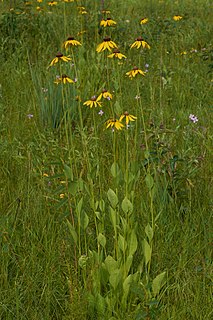
Rudbeckia grandiflora, commonly called rough coneflower, is a species of flowering plant in the aster family (Asteraceae). It is native to North America, where it is found primarily in the south-central United States, including a disjunct population in northwest Georgia. The other populations farther east, all small and isolated, are believed to have originated from human introductions.
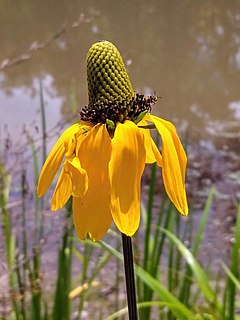
Rudbeckia texana, commonly known at Texas coneflower or shiny coneflower, is a perennial plant in the family Asteraceae native to the Western Gulf coastal grasslands of Texas and Louisiana.
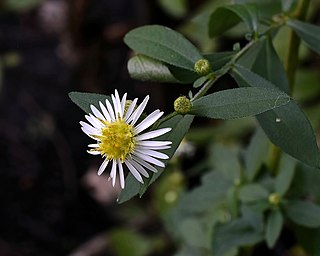
Symphyotrichum ontarionis is a species of flowering plant in the family Asteraceae native to eastern North America. Commonly known as Ontario aster, bottomland aster, and aster du lac Ontario (French), it is a perennial, herbaceous plant that may reach 120 centimeters high. Each flower head has many tiny florets put together into what appear as one.
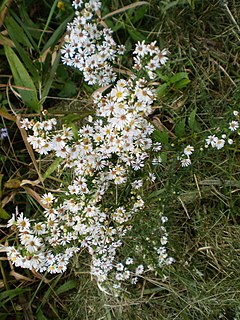
Symphyotrichum racemosum is a species of flowering plant native to parts of North America. It is known as smooth white oldfield aster, small white aster, and aster à grappes (French). It is a perennial, herbaceous plant in the family Asteraceae. It is a late-summer and fall blooming flower.



















